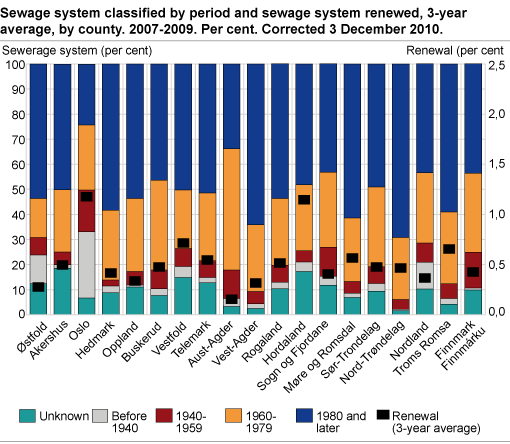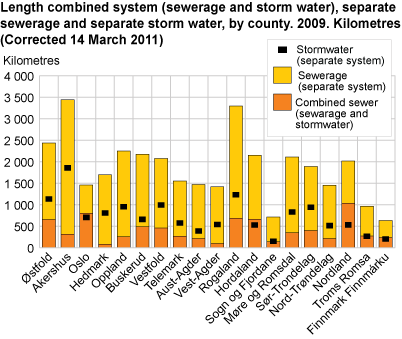Content
Published:
This is an archived release.
0.5 per cent renewal of sewage system
In 2009, 0.47 per cent (164 kilometres) of existing sewage pipeline system was renewed. Renewal of old pipelines was less than half the rate of installation of new sewage pipelines, which was 1.23 per cent (432 kilometres). Total sewage pipelines are estimated at 35 200 kilometres.
Unless renewal increases to a higher level, this will unavoidably lead to aging wastewater pipelines throughout the municipalities. Even without new installations, it will - given the current renewal rate - take more than 200 years to renew the whole pipeline system.
Most renewals in Oslo and Hordaland
Renewals tend to vary from one year to another. The key figure “Percentage of total sewage pipeline system renewed, 3-year average” will downsize these cyclical variations. The municipalities in the counties of Oslo (1.16. per cent), Hordaland (1.13 per cent) and Vestfold (0.70 per cent) renew the most, while Vest-Agder (0.30 per cent), Østfold (0.26 per cent) and Aust-Agder (0.14) renew the least.
The renewal of sewage pipelines is of critical importance to prevent damage to buildings and pollution through leakages. Leaking pipelines can also contribute to higher treatment costs as surface water and groundwater can enter the pipelines.
Akershus and Rogaland have the longest sewage system
Estimations for 2009 show that there are around 35 200 kilometres of municipal sewage pipelines in the whole country (not including separate storm water pipelines), which is equal to approximately 88 per cent of the circumference of the earth at the equator. The sewage pipelines can be divided into 7 600 kilometres of combined sewage and storm water and 27 600 kilometres with a separate sewage system. The municipalities in the counties of Akershus and Rogaland hold the longest sewage system, while counties in Nordland have the largest share of combined sewer systems.
In addition to the 35 200 kilometres of sewage systems, there is also an additional 13 800 kilometres1 of separate storm water pipelines. Hence, there are around 49 000 kilometres1 of municipal wastewater pipeline systems in Norway.
Different types of wastewater pipeline systemsThere are three main groups of wastewater pipeline systems: (1) Combined sewer (both sewerage and storm water) (2) Separate sewerage (3) Separate storm water What is referred to as sewerage pipeline system in this article includes only the two first categories, while separate storm water system is excluded. Private house connections are also not included. |
Half the sewerage system less than 30 years old
A total of 4.5 per cent of the municipal sewage pipelines were installed before 1940, while 50.9 per cent were installed in 1980 or later. In addition, the installation date of 10.4 per cent of the pipelines is unknown, but it is likely that they are old. The renewal rate for this category is relatively high at 1.8 per cent in 2009. By comparison, there was a 0.39 per cent renewal rate for sewage pipelines installed before 1940 and a renewal rate of 0.21 per cent for pipelines installed in 1980 or later.
One pumping station every four kilometres
Pumping stations are sometimes used to direct wastewater against gravity (uphill etc). For 2009 it has been estimated that there are around 8 700 municipally-owned pumping stations in Norway; an average density of 0.25 pumping stations per kilometre.
Variation in standard of sewerage pipeline systems
According to the 2009 figures, there were 90 sewage overflows per thousand kilometre of municipal pipeline system in the country. This constitutes a 7 per cent decrease compared to 2008.
The figures are not only related to the age of the pipeline systems, but there is a tendency that older pipelines give rise to more sewage overflows. In municipalities where the average age was below 25 years, the figure was 56 sewage overflows per thousand kilometre of pipelines, while this figure was 94 in municipalities with pipelines older than 50 years.
84 per cent of inhabitants connected to wastewater facilities of 50 pe or more
In 2009, it was calculated that there are around 84 per cent of inhabitants connected to municipal wastewater facilities of 50 person equivalents (pe) or more. Private solutions are most common among small wastewater facilities (less than 50 pe). The 1.0 per cent deviation between reported data on inhabitants connected and official population statistics - shown in the table - reflects the uncertainty in the reported data for inhabitants connected.
| Number of inhabitants | Percentage | ||||||||||||||||||||||||||||||||||||||||||||||||||||||||||||||||||||||||||||||
|---|---|---|---|---|---|---|---|---|---|---|---|---|---|---|---|---|---|---|---|---|---|---|---|---|---|---|---|---|---|---|---|---|---|---|---|---|---|---|---|---|---|---|---|---|---|---|---|---|---|---|---|---|---|---|---|---|---|---|---|---|---|---|---|---|---|---|---|---|---|---|---|---|---|---|---|---|---|---|---|
| Total number of inhabitants reported connected | 4 749 771 | 100.0 | |||||||||||||||||||||||||||||||||||||||||||||||||||||||||||||||||||||||||||||
| A. Number of inhabitants connected to wastewater treatment plants 50 pe or more | 3 996 481 | 84.1 | |||||||||||||||||||||||||||||||||||||||||||||||||||||||||||||||||||||||||||||
| whereof connected to municipal wastewater treatment plants | 3 965 562 | 83.5 | |||||||||||||||||||||||||||||||||||||||||||||||||||||||||||||||||||||||||||||
| whereof connected to non-municipal wastewater treatment plants | 30 919 | 0.7 | |||||||||||||||||||||||||||||||||||||||||||||||||||||||||||||||||||||||||||||
| B. Number of inhabitants connected to wastewater treatment plants less than 50 pe or more | 753 290 | 15.9 | |||||||||||||||||||||||||||||||||||||||||||||||||||||||||||||||||||||||||||||
| whereof connected to municipal wastewater treatment plants | 90 483 | 1.9 | |||||||||||||||||||||||||||||||||||||||||||||||||||||||||||||||||||||||||||||
| whereof connected to non-municipal wastewater treatment plants | 662 807 | 14.0 | |||||||||||||||||||||||||||||||||||||||||||||||||||||||||||||||||||||||||||||
| For comparison: Official population statistics 01.01.2009 | 4 799 252 | 101.0 | |||||||||||||||||||||||||||||||||||||||||||||||||||||||||||||||||||||||||||||
| Deviation between connection to municipal wastewater plants and official population statistics | -49 481 | -1.0 | |||||||||||||||||||||||||||||||||||||||||||||||||||||||||||||||||||||||||||||
| 1Corrected at 14 March 2011 |
The statistics is now published as Municipal wastewater.
Contact
-
Gisle Berge
E-mail: gisle.berge@ssb.no
tel.: (+47) 48 12 19 97


